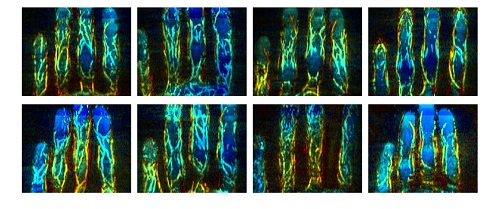
3D Mapping of Finger Veins Points to Uncrackable Security
An optical biometric authentication tool using photoacoustic tomography to map a subject’s finger veins in 3D could provide a nearly uncrackable security method. Researchers at SUNY Buffalo developed the biometric authentication technique. Tests showed that the method performed with 99% accuracy in accepting and/or rejecting identities.

Photoacoustic finger vessel images from eight different subjects. Different colors represent different depths. Courtesy of Jun Xia, SUNY Buffalo.
“The 3D finger vein biometric authentication method we developed enables levels of specificity and anti-spoofing that were not possible before,” said Jun Xia, research team leader in the optical and ultrasonic imaging laboratory. “Since no two people have exactly the same 3D vein pattern, faking a vein biometric authentication would require creating an exact 3D replica of a person’s finger veins, which is basically not possible.”
Other biometric authentication approaches based on finger veins have been developed, though they have relied on 2D images. The addition of a third dimension increases security by making it vastly more difficult to counterfeit an identity, and less likely that the security measure will accept the wrong person.
To accomplish 3D biometric authentication, the researchers used photoacoustic tomography, a method that combines light and sound. First, laser light is used to illuminate the finger. When the light hits a vein, it creates a sound that is then detected with an ultrasound detector, which then constructs a 3D image of the vein pattern.
“It has been challenging to use photoacoustic tomography for 3D finger vein biometric authentication because of the bulky imaging system, small field of view, and inconvenient positioning of the hand,” Xia said. “We addressed these issues in the new system design through a better combination of light and acoustic beams and custom-made transducers to improve the imaging field of view.”
To improve the integration of light illumination and acoustic detection, the researchers fabricated a new light and acoustic beam combiner, as well as an imaging window that allows the hand to be naturally placed on the platform, similar to a fingerprint scanner. Wenyao Xu of the computer science and engineering department developed a matching algorithm that allows biometric identification and matching of features in 3D space.
The system was tested with 36 volunteers whose four left and four right fingers were imaged. Tests showed that the approach was both feasible and accurate, especially when multiple fingers were used.
“We envision this technique being used in critical facilities, such as banks and military bases, that require a high level of security,” said research team member Giovanni Milione. “With further miniaturization, 3D vein authentication could also be used in personal electronics or be combined with 2D fingerprints for two-factor authentication.”
Biometric authentication technology is an alternative to traditional passwords in a variety of applications, and currently the researchers are working to make their system smaller and reduce imaging time to less than one second. They said that it should be possible to implement the photoacoustic system in smartphones, since ultrasound systems have already been developed for use in smartphones. This could enable wearable systems that perform biometric authentication in real time.
The research was published in Applied Optics (www.doi.org/10.1364/AO.400550).
Published: September 2020